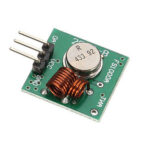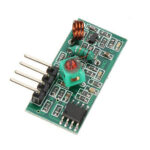433MHz RF Transmitter Receiver modules are wireless communication modules that use radio frequency (RF) as a signal.
Introduction to 433MHz RF Transmitter Receiver modules
433MHz RF Transmitter Receiver modules are wireless communication modules that use radio frequency (RF) as a signal. They are similar to what is used in some remote-controlled toys. The modules are packaged separately as a transmitter module and a receiver module.
The receiver module can detect and output any radio signal in the 433 MHz range, whereas the transmitter module can transmit a signal in this range via an input. There are also other modules that can handle frequencies in the 315 and 330MHz ranges.
433MHz RF Transmitter and Receiver modules are easy to come by and by doing some internet searching, single modules can be obtained for around ZAR30. Good sources include eBay, Amazon and BangGood. Some modules are obviously better quality than others. Apart from being inexpensive, they are small and, with the correct information, they are pretty easy to get up and running on a microcontroller like the Arduino and Raspberry Pi using digital pins.
- Get the 433Mhz RF Transmitter Receiver Module Kit from Amazon.com or BangGood
- Get the Microelectronics Starter Kit from Amazon.com or BangGood
- Get the Basic Arduino Uno R3 Starter Kit from Amazon.com or BangGood
Sample uses and alternatives
433MHz RF Transmitter Receiver modules work well for short to long-distance wireless communication. It can be used to distinguish voltage changes (e.g. simple on-off-like behaviour) or, with some additional programming packages, it can transmit more refined signals such as string variables. These modules are popular to use with 433MHz remote controls.
Alternative wireless communication modules include the XBee (IEEE 802.15.4-2003 ) point-to-point modules, Bluetooth modules and the increasingly popular ESP32 and other ESP8266-related Wi-Fi modules.
Laser Transmitter Receiver modules can also be used for short-distance wireless communication.
433MHz RF Transmitter Receiver specifications
Transmitter (square unit)
 Pins: 3. Gnd (closest to Ant), Pwr, Tx/ATAD (‘DATA’). Breadboard friendly. Pins might be marked. ‘R’ might also be present on some units indicating receiver.
Pins: 3. Gnd (closest to Ant), Pwr, Tx/ATAD (‘DATA’). Breadboard friendly. Pins might be marked. ‘R’ might also be present on some units indicating receiver.
Signalling: Digital (digital read). Data to be transmitted is read by the Transmitter’s digital pin.
Input voltage: 3 ~ 12 V DC (for max power use 12 V)
Input current: max ≤ 40 mA (12 V) max, min≤9 mA (3 V)
Resonance mode: SAW
Modulation mode: ASK
Working frequency: 315 MHz to 433 MHz (some have customisable frequency)
Transmission power: 25 mW (315 MHz at 12 V)
Frequency error: +150 kHz (max)
Velocity: less than 10 Kbps
Self-owned codes: negative
Size: 19 x 19 x 7 mm
Breadboard friendly: yes
Pin size: male, 5 x 2.54 mm
Receiver (longer unit)
 Pins: 4. Pwr (closest to Ant), Rx, Rx, Gnd. Breadboard friendly. Pins might be marked.
Pins: 4. Pwr (closest to Ant), Rx, Rx, Gnd. Breadboard friendly. Pins might be marked.
Signalling: Digital (requires interrupts, digital write). Data that is received is transmitted by the Receiver’s digital pin.
Input voltage: 5.0 V DC +0.5 V
Working current: ≤5.5mA max
Working method: OOK/ASK
Working frequency: 315 MHz – 433.92 MHz
Bandwidth: 2MHz
Sensitivity: excel –100 dBm (50 Ω)
Transmitting velocity: <9.6 Kbps (at 315 MHz & -95 dBm)
Size: 30 x 14 x 7 mm
Breadboard friendly: yes
Pin size: male, 5 x 2.54 mm
Antennae and communication distance
Even if already pre-attached, additional antennae can be added to both the receiver and transmitter modules. Antennae will increase the potential communication distance between the units. To get started, a simple solid copper wire (e.g. 1 mm thick and 18 to 25 cm long) can be soldered onto the pin (usually) marked ANT.
Better results can be obtained by coiling the antenna.
Commercial antennae are also available.
Get the 5mm 433Mhz Spiral Helical Antenna from Amazon.com or BangGood
It is reported that the maximum communication distance is up to 90 m in an open area (not tested). Apart from a proper antenna and higher voltage, a reduction of the baud rate through programming (allowable range between 300 and 2400 bps) will increase the range and effectiveness.
Other important things to know
Communication is only one way — from the transmitter to the receiver.
Because random outside radio signals are being sent and received from many close-by devices, the receiver module is also prone to pick up ‘false’ signals (called ‘noise’).
Receivers are only able to read single short bursts of signal at a time — which becomes a bit of a problem if more than a few transmitters are sending code at the same time.
Conclusion
433MHz RF Transmitter Receiver modules are wireless communication modules that use radio frequency (RF) as a signal. They are popularly used for short to long-distance wireless communication in remote controls.



lekker man, nice work, now adding this to each solar panel to track failure, power output and charge as well as power drop. Also a meter to track use and power “sold” to the power network and battery backup, all possible using the Pi4… and Arduino and 3D printer…